The skeleton of the ancient city of Hampi expands over a vast area—as far as the eyes can see.

Walking the passages cut through the dangerous crevices between huge boulders, we were now heading towards the banks of the Tungabhadra river.
Though October to March is considered the best time to visit Hampi, the winter sun of December continued to shine mercilessly on us.
The scorching heat and the dust make a nasty combination of sweat and dirt on your skin. However, if you are with friends, don’t worry, you all will appear equally tanned and covered in the red sand.
Keep your gear ready with these essentials—2 bottles of water per person, a cap/hat, sunglasses, sunscreen, a good pair of shoes, some snacks.
We had rented cycles, from the locals—they had set up a small corner, renting two-wheeler on a small lease amount, for the whole day. The cycles did help us on the long stretches of roads linking different stone monuments.
The cycles were hired at rupees 150 per person after some bargaining.
Cycling is the most convenient way to discover places in Hampi though you won’t be able to reach all of them by dragging a bicycle along with you. Walking on foot is your second option, but could be tiring and time-consuming if you want to explore the entire Hampi.
Alternatively, hire a bike or taxi. You would still have to walk or trek to see a few places that are on the hilltop.
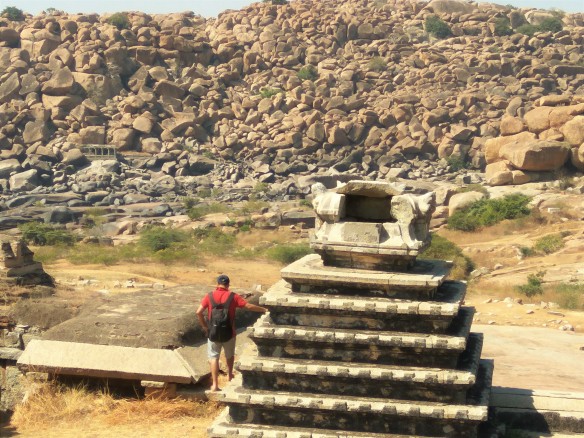
Things changed quickly. It wasn’t a pleasant experience walking over a massive stretch of rock and carrying our cycles instead of riding them. We parked them in a corner with the hope that nobody would steal them and continued on foot from there.
The labyrinth through the gigantic boulders somehow opened into a stretch of a rock base that descended into the Tungabhadra river.

Tungabhadra River, Hampi Picture Credits: Akshayrajsinh Jadeja
Laying our feet in the refreshing and cool water on the slippery and rocky banks of the river, I released a breath of relief. The calm breeze that rushed closer to the water along its rugged banks welcomed me in its territorial land.

Coracle ride along the banks to ferry you across the river
There was an upturned coracle (a huge circular boat, which has a framework of bamboo sticks, reeds, and plastic sheets)—waiting for its passengers to be ferried to the other side of the river.
The charges for the coracle ride was 500 Indian Rupees per person.
We rejuvenated ourselves with a hot cup of sugary tea in small tea-shop built under the shades of a vast tree.
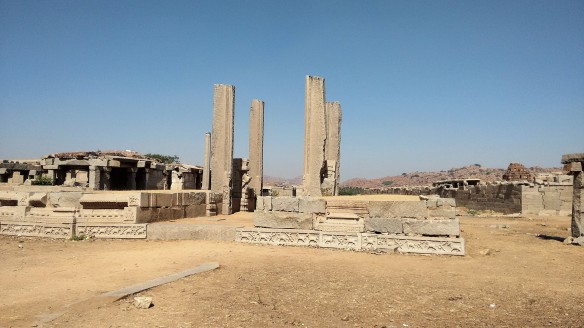
After regaining our strengths, we braved the sun to watch the ruins of Hampi, which is scattered over an enormous stretch of the land, belonging to the capital city of the Vijayanagar Empire.

King’s Balance, source: wikimedia.org
We crossed the famous King’s Balance—of what remained only two gigantic 15-foot tall pillars. The balance was weighed with gold, silver, rubies and all precious things equal to the weight of the king who would sit on the other end of the balance. This was distributed among the priests and the people of the kingdom.
Vitthala Temple
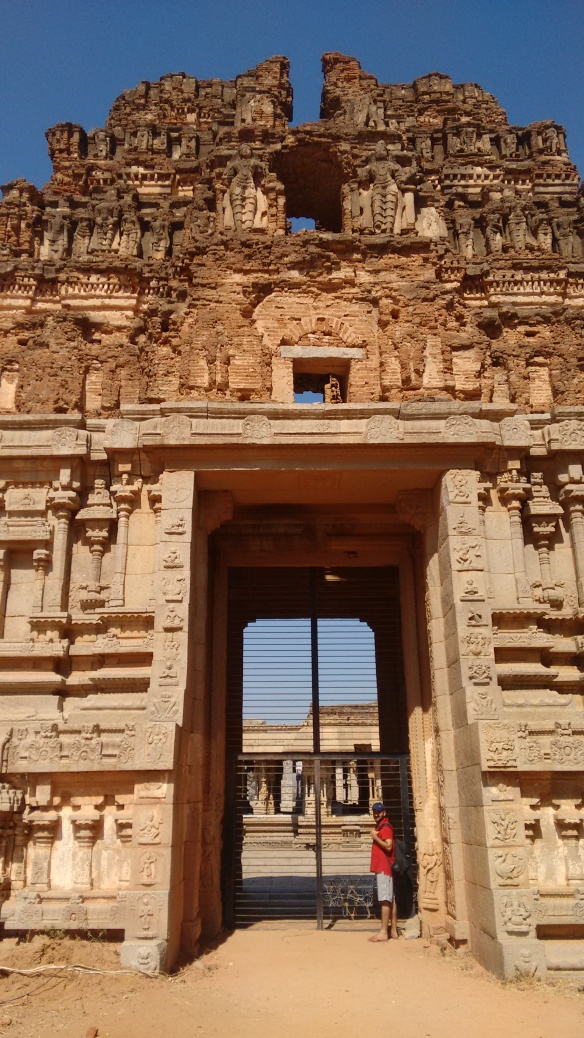
One of the entrance gates at Vitthalla temple

A closer look at the art
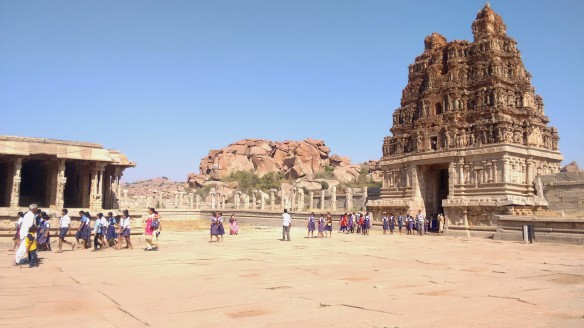
Vitthalla Temple Compound

Our next stop was the majestic compound of the Vitthalla temple that was surrounded by stone walls on the four sides. We covered a little over a kilometre on foot.
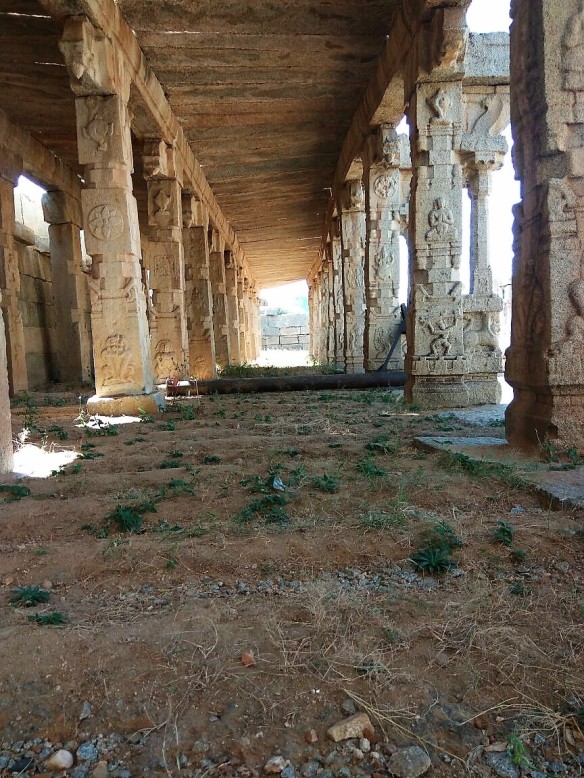
Temples supported by stone pillars embellished with beautiful carvings. Below, these abandoned temples probably held a sculpture of Gods and Goddesses, which are nowhere to be seen now.
On our way, we saw lifeless ruins covered with dust and vegetation cropping from the unattended corners and gaps of the structures that seemed to be the places of worship in ancient times.
When we reached the remains of the Vitthalla compound, the area was brimming with people while the architecture lulled us to the huge entrance gate.
We couldn’t take our eyes off the remarkable brick and stonework that offered a glimpse of the life of people who would have at one time lived peacefully under the roof of these ancient structures.
The Stone Chariot
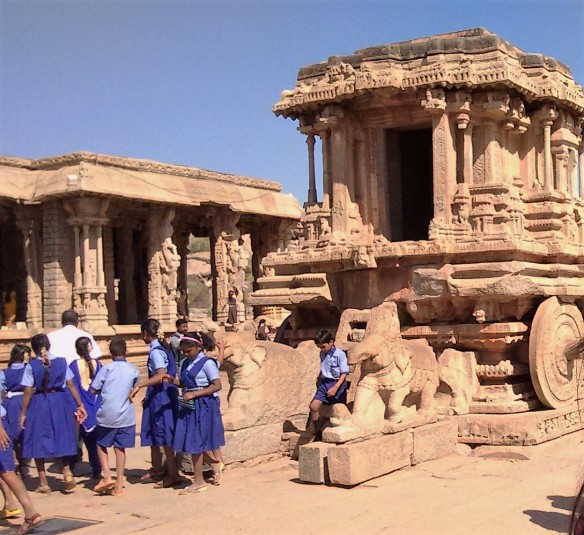
Vitthalla temple holds in its compound one the most iconic piece of Indian stone art—the Stone Chariot. It may look like a monolithic structure—cut out of a single piece of rock. However, Stone Chariot has been built using blocks of granite rock placed over one another with such dexterity and skill that the structure attracts attention in a single glance.
The Stone Chariot is an imitation of the Konark Sun Temple in Orissa that inspired Vijaynagar’s famous king Krishnadevaraya to build a similar structure in his empire.
The 16th century stone architecture hosted Garuda, the mount of Lord Vishnu—but the sculpture is nowhere to be seen today. The chariot rests on a granite base, about 1 foot above the ground with life-size wheels and axle carved out of the rock to perfection.


Picture Credits: Akshayrajsinh Jadeja
Architectural structures have innumerable stories depicted on its walls—the chariot temple and other structures in the Vitthalla temple compound have scenes of war engraved on their walls.
The stone elephant sculptures in the front of the temple that seemed to be pulling the chariot were built to replace broken horse sculptures that stood there before—their remains can still be seen.
There is a stone ladder in between them, which was used by the temple priests to reach the sanctum for offering prayers to the Garuda.

The Stone Chariot
It is believed by the people of Hampi that if the chariot is moved from its place, the world will come to an end. We can just hope that the stone structure stands remains intact and static as a remnant of the ancient Hampi.

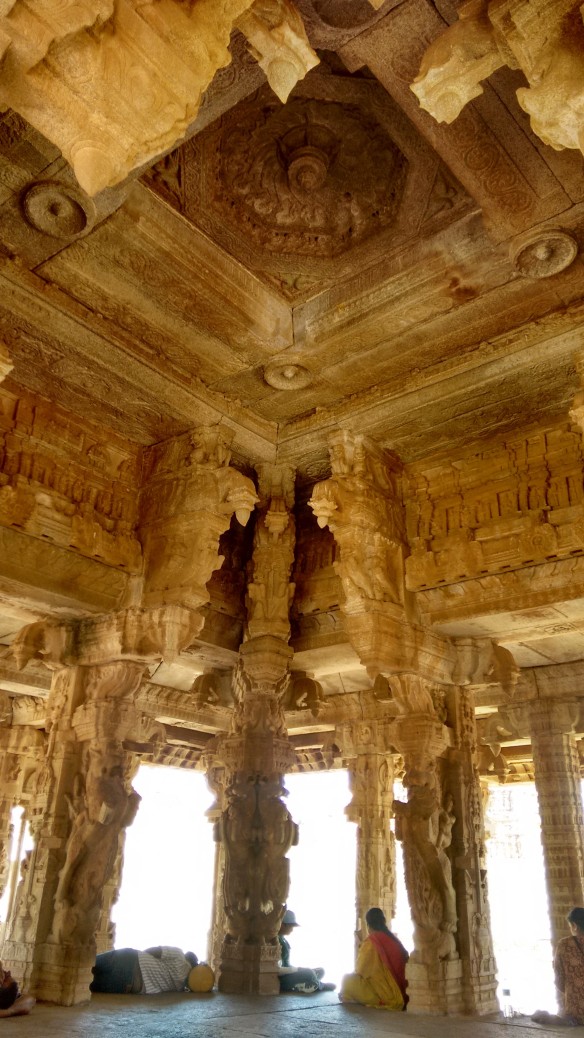
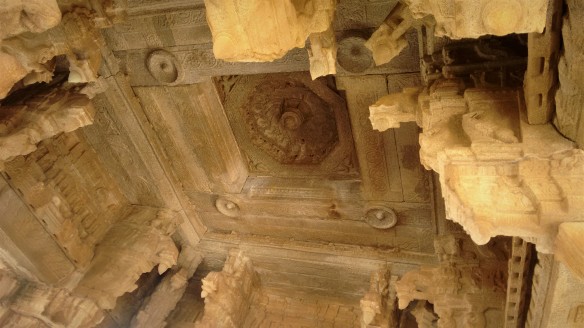

There are various stone structures around the chariot in the same compound of Vitthalla temple—it may take you around an hour to have a look at each of them.
If you wish to know the stories associated with each of these structures and want to go into the depths of the time, you can easily hire guides to show you the place along—these are official tourist guides and have ample knowledge about the magnificent history of the place.

We have reached the end of this ancient world, next to the Vitthalla temple compound
From here, you could either retreat or move ahead to the remains of the Queens’s Palace, where you could relax and enjoy the evening sun. And how could we miss mentioning the Archaeology Museum, the treasure holds the collection of old photographs of Hampi and valuable remnants from the past.
Keep a separate day for Queen’s Palace, Lotus Mahal, Elephant Stables, including the museum.
Want to know where to begin when you reach Hampi? Here is your tour guide for the first day.


